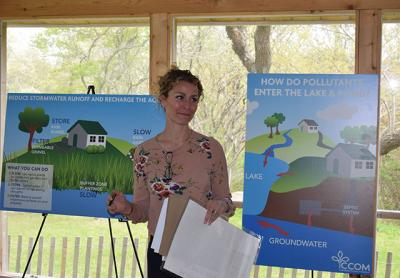New Round of Water Tests at Montauk's Fort Pond

Against a backdrop of Fort Pond’s tranquil blue water, officials of Concerned Citizens of Montauk announced a partnership with Christopher Gobler of Stony Brook University on Monday, under which Dr. Gobler’s lab will analyze water samples taken from the pond by C.C.O.M. in order to monitor harmful algal blooms, which appeared in 2015 and last year.
The announcement comes as the East Hampton Town Board moves toward creation of a wastewater treatment system, and a tax district to fund it, for Montauk’s densely developed downtown, acting on the belief that excessive nitrogen loading is behind the pond’s ecological woes.
Starting this month, C.C.O.M. officials will collect water samples biweekly; from June through September, samples will be collected weekly. Dr. Gobler’s analysis of them will be the basis for posting public health advisories, if necessary, and tracking the onset and persistence of harmful algal blooms, Laura Tooman, C.C.O.M.’s president, said.
“This information is not just important to signify that we have an environmental crisis,” she said. “It’s also to help notify the public for health and safety reasons.”
Depending on sample analysis and conditions during the summer season, weekly testing may continue through October, or be reduced to biweekly, Ms. Tooman said.
C.C.O.M.’s funding, sourced through grants and donations, will cover the costs of the sampling and transportation to Dr. Gobler’s lab; the State Department of Environmental Conservation will pay for the processing of the samples.
Dr. Gobler has been monitoring water under the jurisdiction of the town trustees for five years, with a particular focus on Georgica Pond in East Hampton, which has experienced toxic blooms of cyanobacteria, or blue-green algae, in each of the last several summers. His lab also analyzes water collected from lakes, ponds, and other water bodies on Long Island and in New York City for the D.E.C.
On Monday, Dr. Gobler and C.C.O.M. officials were joined, at Fort Pond House at Carol Morrison Park, by officials including Supervisor Peter Van Scoyoc, Councilwoman Sylvia Overby, and Councilman David Lys of the town board; Peter Scully, the deputy county executive; County Legislator Bridget Fleming, and Carrie Meek-Gallagher, the D.E.C.’s regional director. Nearly all of them emphasized the importance of science and data-driven decision making as the impetus for Dr. Gobler’s hiring.
Last summer, the swimming portion of the MightyMan Montauk Triathlon was canceled because of a dense blue-green algae bloom in Fort Pond. That, Dr. Gobler said, was “a sign that things are not as they should be.” Harmful algal blooms, he said, are a symptom of the misuse of land.
“The big issue here is we know very little about what’s going on in Fort Pond,” Dr. Gobler said. “Not a lot of data has been collected. We’ve received samples on occasion over the last several years, but only a handful. To address the problem, we really need to get more information. This is step one.”
By year’s end, “we’ll have a very robust data set,” he said, calling that “the first step toward turning this around and improving things.”
Ms. Fleming noted that cyanobacteria were detected last week in Lake Agawam in Southampton, and in Shinnecock Bay shortly before that. “The attack is largely due to human activity,” she said. “This, in combination with climate change, means that unless it’s all hands on deck for a solution, it’s going to get worse before it gets better. . . . We at the legislative level, the county level, certainly at the state level, have said this is a crisis and we need to address it. But the only way that government can be effective is by partnering with academic institutions and environmental institutions, and particularly to ensure that our efforts are data-driven.”
The county government, she said, is committed to “taking the science that you’re going to bring to us and doing what we can, working with the community, to try to resolve this problem. It’s a big deal, but we are in it until we win it.”
Mr. Scully, a former regional director of the D.E.C., said that while Long Island may be experiencing a water-quality crisis, “If we have one thing going for us, it’s the fact that we have tremendous academic and science-based institutions that are helping us to evaluate the situation.” The problem, he said, “did not occur overnight, it’s not going to be fixed overnight,” but Dr. Gobler’s engagement “is a huge step forward for us.”
The discussion veered into related topics. “We have a fairly good idea that septic systems are a huge contributing factor to this,” Ms. Tooman said, with several officials talking about the importance of replacing primitive and failing septic systems with state-of-the-art systems that reduce nitrogen, and the programs to encourage homeowners to do that. A community oyster garden program has proven popular and, in its third year, will grow considerably, an effort to clean the water through natural processes, as oysters are filter-feeding organisms. And the town board, Mr. Van Scoyoc reminded those in attendance, is acting on a wastewater treatment district for the hamlet’s downtown.
“It’s not just these isolated issues, it’s all tied into one bigger picture, which is that we really have to start paying more attention and take better care of the place where we live,” the supervisor said. “We can do that in small ways, we can do that in big ways, but we need to do all of it, as much of it as we can, now and into the future so we can ensure that what’s so beautiful about this place remains for all to enjoy.”
